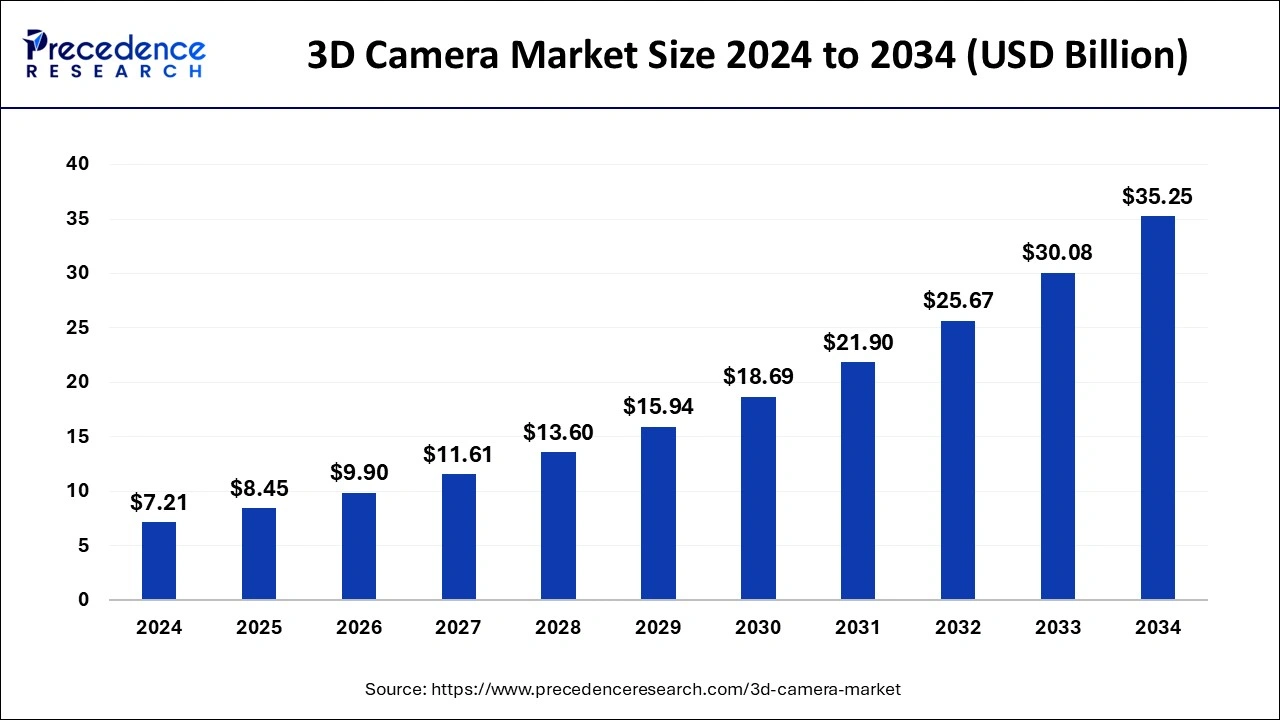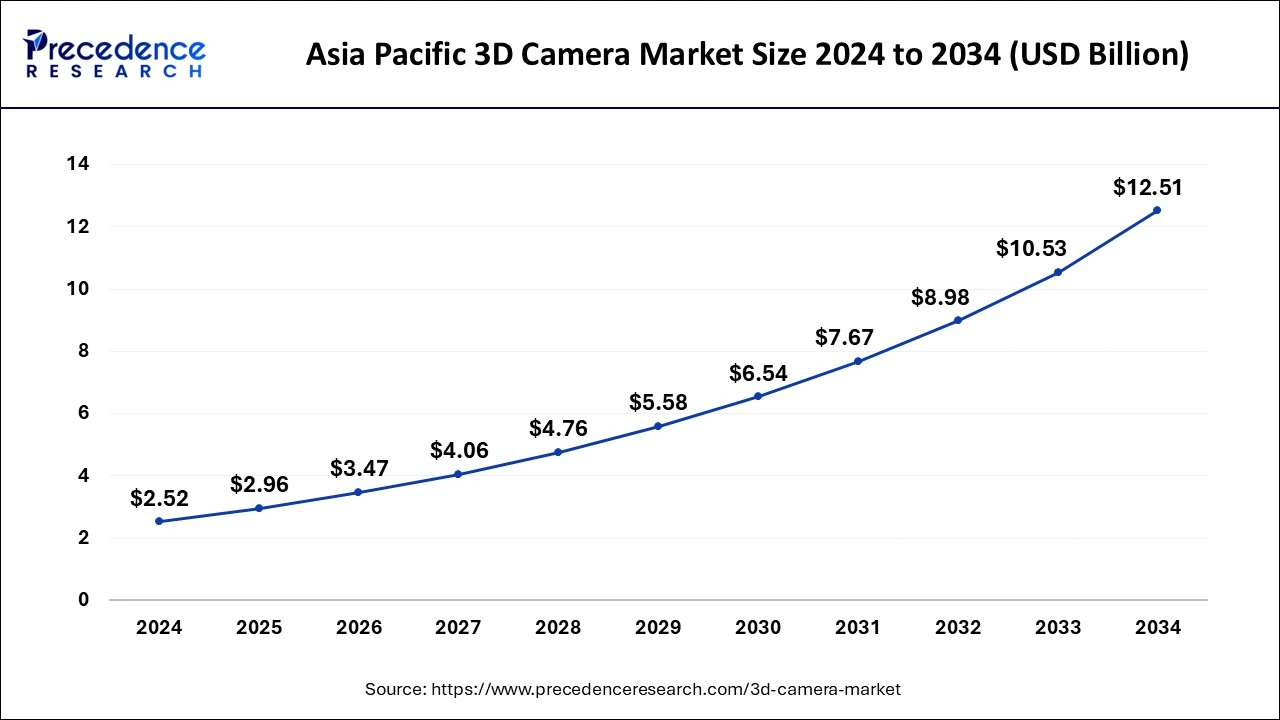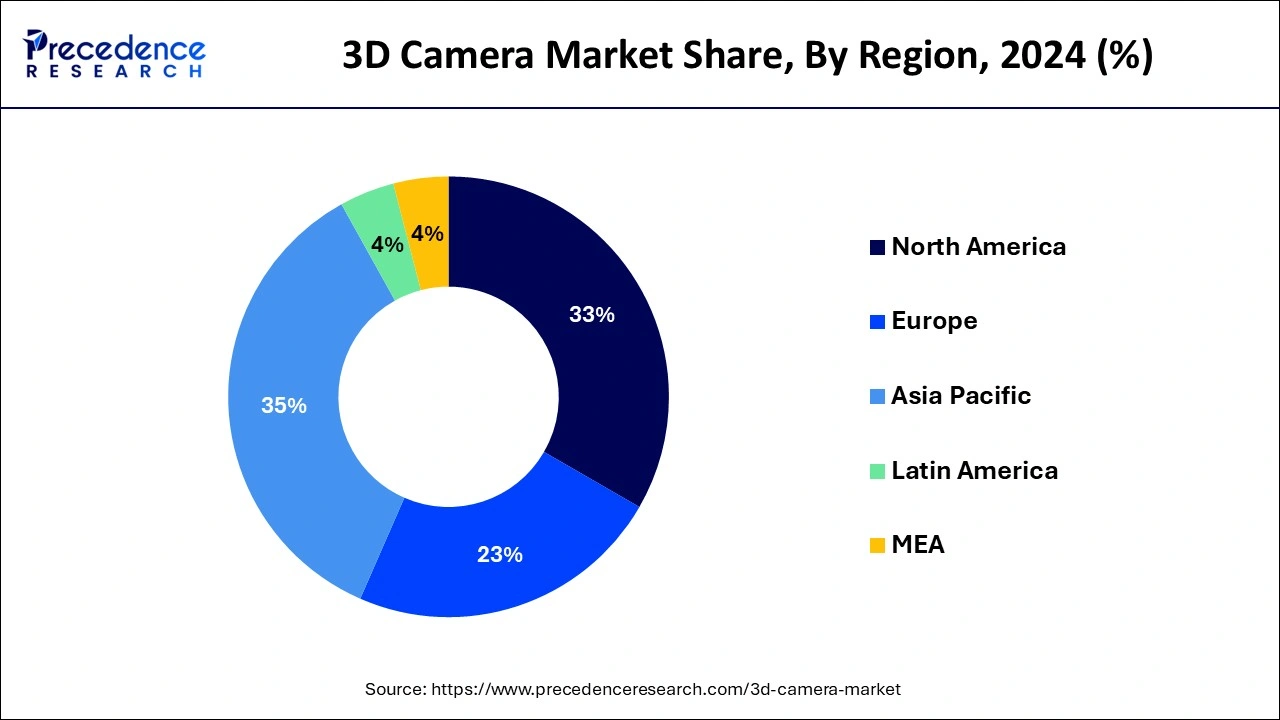January 2025
The global 3D camera market size is estimated at USD 8.45 billion in 2025 and is predicted to reach around USD 35.25 billion by 2034, accelerating at a CAGR of 17.20% from 2025 to 2034. The Asia Pacific 3D camera market size surpassed USD 2.96 billion in 2025 and is expanding at a CAGR of 17.37% during the forecast period. The market sizing and forecasts are revenue-based (USD Million/Billion), with 2024 as the base year.
The global 3D camera market size was estimated for USD 7.21 billion in 2024 and is anticipated to reach around USD 35.25 billion by 2034, growing at a CAGR of 17.20% from 2025 to 2034. The growth of the 3D camera market is majorly driven by the improvement in 3D scanning technology, rapid advancements in computational photography, increasing use of technologies like self-driving cars, drones, and robots, and rising industrial applications of 3D cameras.

Artificial intelligence (AI) integration has opened up new possibilities and paved the way for the future of 3D cameras. 3D cameras offer depth information and AI algorithms process this data for several crucial applications, enabling advanced capabilities including motion tracking, object recognition, and scene analysis. 3D vision technology enters the equation, offering Artificial intelligence with the precise visual data necessary to interpret and interact with the physical world. AI-enhanced 3D cameras are widely used across various industries, including robotics, manufacturing, gaming & entertainment, healthcare, and autonomous vehicles. AI integration offers high-quality assurance, navigation assistance, and object identification.
By leveraging the strengths of AI in 3D vision assists in achieving new levels of accuracy, efficiency, and reliability. This camera comes equipped with several advanced features that enable it to detect objects, mark serial numbers, and others. The AI-powered 3D camera allows it to detect objects even in cluttered workspaces which makes it the perfect choice for use in manufacturing and production environments.
The Asia Pacific 3D camera market size was estimated at USD 2.52 billion in 2024 and is anticipated to be surpass around USD 12.51 billion by 2034, rising at a CAGR of 17.37% from 2025 to 2034.

Asia Pacific dominated the global 3D camera market with the largest market share of 35% in 2024. Due to the significant smartphone sector in the region, which is expected to be a target industry for 3D cameras over the projection period, Asia Pacific is a very lucrative region of the worldwide market. The growth of the region's construction, automotive, and healthcare industries is having a big positive impact on the market for 3D cameras. In 2024, the market for 3D cameras saw the biggest revenue share in the Asia Pacific region. This is because more people are using smartphones, the entertainment sector is expanding, there is more money available, and fewer people possess cameras. Additionally, the growth of the regional market would be further boosted by the development of the industrial sector in the region's developing countries.

A significant portion of the global market for 3D cameras is projected to come from North America due to the region's rapid adoption of technologies that are increasing the demand for 3D cameras. 3D cameras are widely used in the region in the fields of construction, surveying, surveillance, indoor mapping, entertainment, and sports.
A 3D camera is a type of imaging technology that gives images the appearance of depth to mimic three-dimensional perspectives as perceived by human binocular vision. A single lens that changes position is used by some 3D cameras, while others employ two or more lenses to record different points of view.
The parallax effect is produced by combining the pictures from the two lenses to produce the 3D effect. When looking at an object across two lines of sight, parallax happens. When volumes, forms, and 3D positions and orientations of objects are needed, 3D image processing is quite helpful. It is a depth-sensing innovation that improves camera functionality for object and facial recognition. Utilizing optical technology, 3D sensing technology imitates human vision, enabling the development and integration of augmented reality, artificial intelligence (AI), and the Internet of Things (IoT). This gives consumer applications new opportunities.
The key driver of the worldwide 3D camera market is the entertainment sector's growing demand for and popularity of 3D content. The need for 3D cameras is also being driven by the expanding applications of 3D imaging in home automation, robotics, virtual reality, and video surveillance. Major reasons boosting the demand for 3D cameras include the rising popularity of 3D TVs and the comparatively simple integration of 3D cameras into smartphones.
| Report Coverage | Details |
| Market Size in 2025 | USD 8.45 Billion |
| Market Size by 2034 | USD 35.25 Billion |
| Growth Rate from 2025 to 2034 | CAGR of 17.20% |
| Largest Market | Asia Pacific |
| Base Year | 2024 |
| Forecast Period | 2025 to 2034 |
| Segments Covered |
By Technology, By Types, By Application |
| Regions Covered |
North America, Europe, Asia-Pacific, Latin America, and Middle East & Africa |
Key Market Opportunities
The time-of-flight segment dominated the market in 2024. This is because the technology is widely used in a variety of applications, including smartphones, drones, healthcare, industrial, and automotive. In addition to being resistant to ambient time, the system only considers one viewpoint while calculating depth, which makes it immune to occlusions and shadows while preserving sharp depth borders. As a result, maintaining safety through the recognition of moments and gestures and the provision of real-time information is most desired in the automotive and industrial sectors.
Over the forecast period, stereo vision is expected to maintain its position in 3D cameras. Over the anticipated time frame, the market is expected to grow at a CAGR of 36%. These technologically advanced cameras are inexpensive and simple to design.
The professional camera segment accounted for the highest market share in 2024, the segment has dominated the market and it will continue to grow well in terms of revenue. As the market for 3D movies expands, more professional 3D cameras are anticipated to be used to record live-action movies. Stereo cameras are used to capture motion pictures. Professional 3D cameras are preferred over pricey computer-generated imagery (CGI) to save time and money. The market for 3D cameras is primarily driven by the increased use of these cameras to record 3D content in media and entertainment. The rising use of expert 3D cameras in sectors including manufacturing, building, civil infrastructure, and historical site management is another development driver for the sector.
Over the projected period, it is anticipated that the sector for smartphones and tablets will expand the fastest. The increase is anticipated to be driven by the rising demand for sophisticated cameras equipped with cutting-edge technologies that improve picture and video quality by detecting motions. Among youthful consumers, features like high performance, HD clarity, and real-time sensing are becoming more popular.
By Technology
By Types
By Application
By Geography
For inquiries regarding discounts, bulk purchases, or customization requests, please contact us at sales@precedenceresearch.com
No cookie-cutter, only authentic analysis – take the 1st step to become a Precedence Research client
January 2025
May 2025
February 2025
January 2025